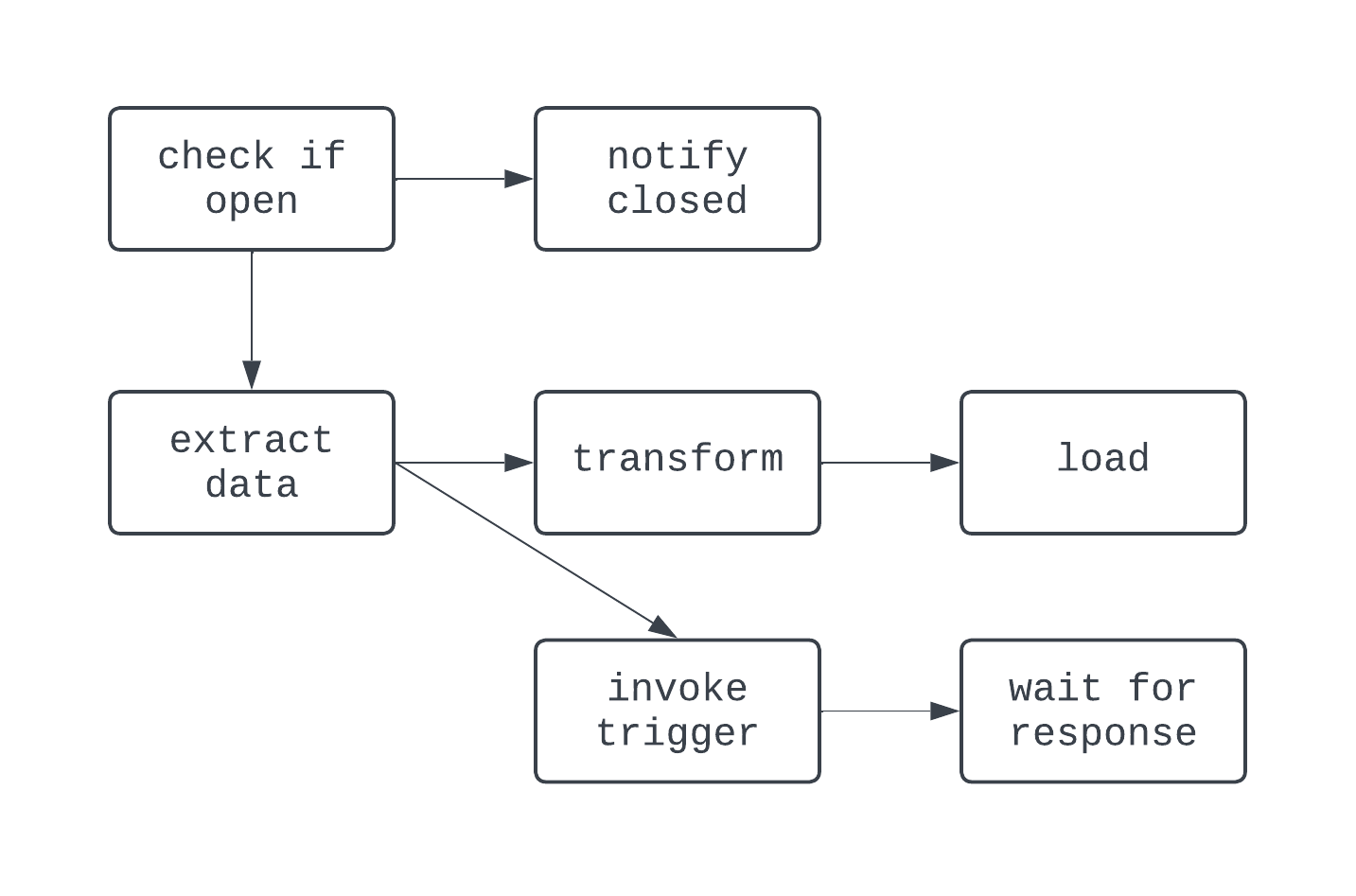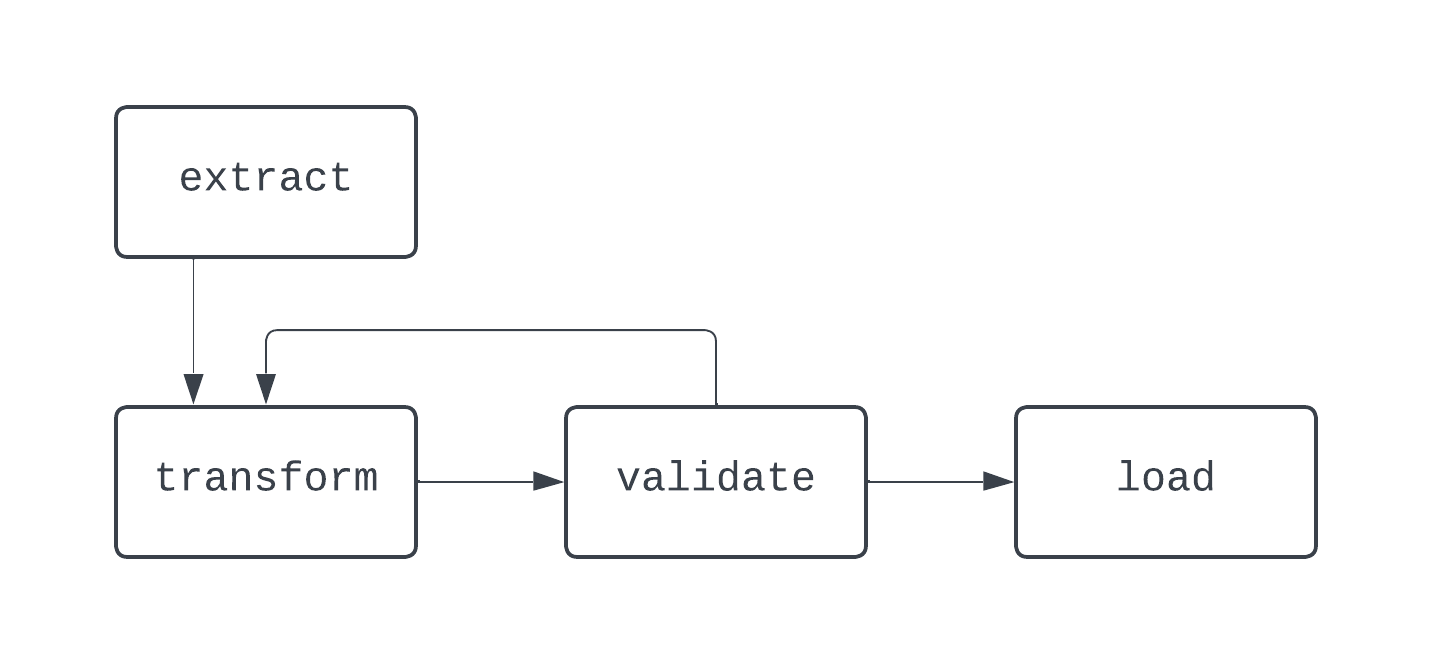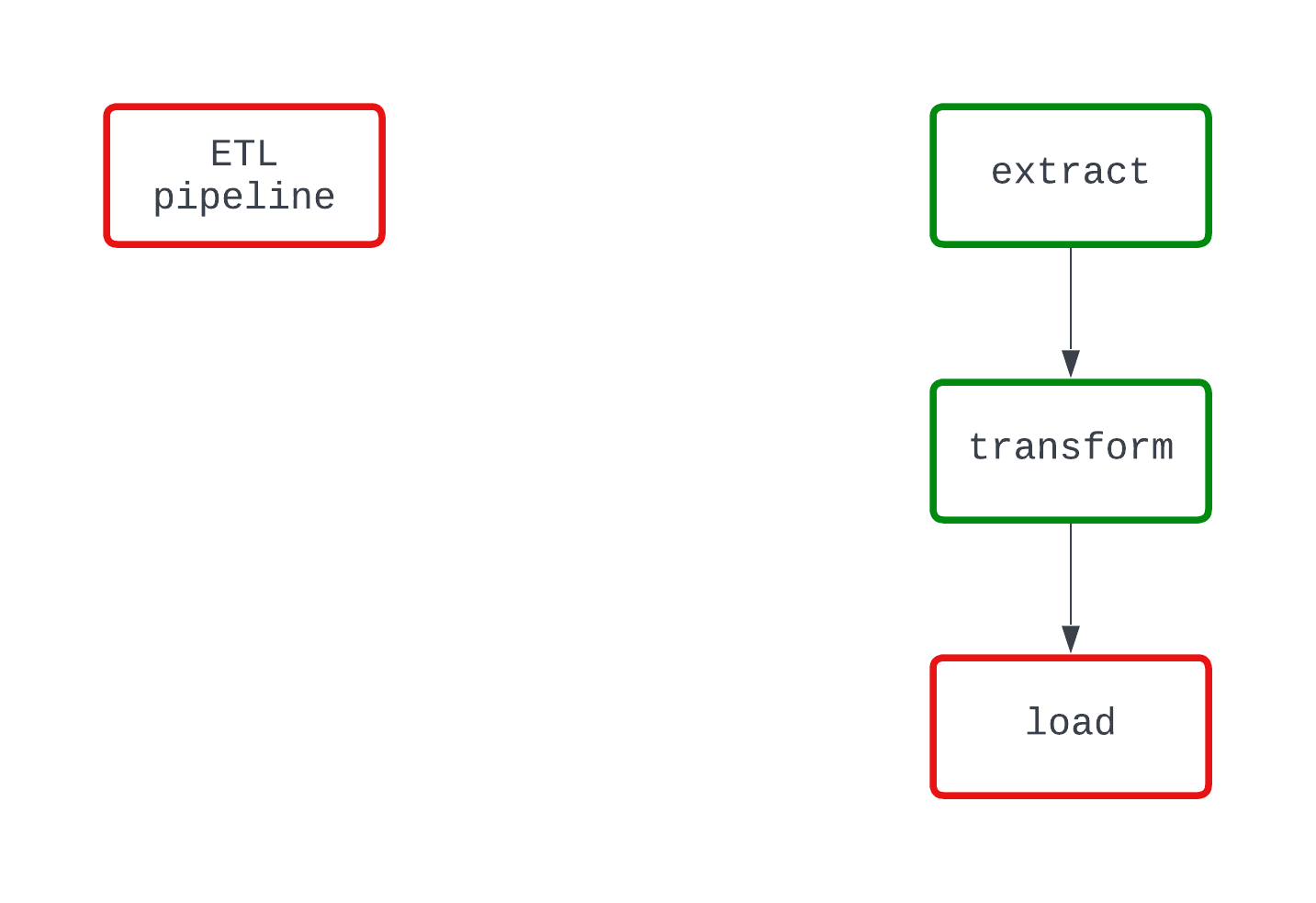Curso
O que é o fluxo de ar Apache?
O Apache Airflow, ou Airflow, é uma ferramenta e uma estrutura de código aberto para executar seus pipelines de dados na produção. Como uma ferramenta de gerenciamento de fluxo de trabalho de dados líder do setor, o Apache Airflow utiliza Python para permitir que os profissionais de dados definam seus pipelines de dados como código. O Airflow adiciona a capacidade de programar a execução do pipeline e observar o desempenho, tornando-o um hub centralizado para todos os seus fluxos de trabalho de dados. Se você estiver preparando dados de treinamento para um modelo ou persistindo dados em um lago de dados, o Airflow adiciona a funcionalidade para tornar seus pipelines de dados prontos para a produção.
O Airflow foi criado pela primeira vez na Airbnb por Maxime Beauchemin em 2014 e depois entrou para o programa Incubator da Apache Software Foundation em março de 2016, antes de ser anunciado como um projeto de nível superior em 2019. De acordo com a pesquisa da Airflow de 2022, o Airflow é baixado milhões de vezes por mês, e milhares de empresas, grandes e pequenas, confiam na ferramenta.
Principais recursos do fluxo de ar
A estrutura do Airflow, bem como sua arquitetura, tem vários recursos importantes que o tornam único. Primeiro, vamos nos aprofundar um pouco mais nos recursos mais importantes da estrutura do Airflow.
Recursos da estrutura do Airflow
A unidade mais simples da estrutura do Airflow são as tarefas. As tarefas podem ser consideradas como operações ou, para a maioria das equipes de dados, operações em um pipeline de dados.
Um fluxo de trabalho tradicional de ETL tem três tarefas: extrair, transformar e carregar dados. As dependências definem os relacionamentos entre as tarefas. Voltando ao nosso exemplo de ETL, a tarefa "load" (carregar) depende da tarefa "transform" (transformar), que, por sua vez, depende da tarefa "extract" (extrair). A combinação de tarefas e dependências cria DAGs, ou gráficos acíclicos direcionados. Os DAGs representam pipelines de dados no Airflow e são um pouco complicados de definir. Em vez disso, vamos dar uma olhada em um diagrama de um pipeline básico de ETL:

O DAG acima tem três tarefas, com duas dependências. Ele é considerado um DAG porque não há loops (ou ciclos) entre as tarefas. Aqui, as setas mostram a natureza direcionada do processo; primeiro, a tarefa extract é executada, seguida pelas tarefas transform e load. Com os DAGs, é fácil ver um início e um fim distintos para o processo, mesmo que a lógica seja complexa, como o DAG mostrado abaixo:

Nesse DAG, a lógica é um pouco mais maluca. Há uma ramificação baseada em uma condição e algumas tarefas são executadas em paralelo. No entanto, o gráfico é direcionado e não há dependências cíclicas entre as tarefas. Agora, vamos dar uma olhada em um processo que não é um DAG:

Nesse diagrama, há um loop distinto entre as tarefas transform e validate. Em alguns casos, esse DAG pode ser executado para sempre, se não houver nenhuma maneira de sair desse loop.
Ao criar pipelines de dados, mesmo fora do Airflow, é uma prática recomendada evitar a criação de fluxos de trabalho que não possam ser representados como DAGs, pois você pode perder recursos importantes, como determinismo ou idempotência.
Recursos da arquitetura do Airflow
Para agendar DAGs, executar tarefas e fornecer visibilidade dos detalhes de execução do pipeline de dados, o Airflow utiliza uma arquitetura baseada em Python composta pelos componentes abaixo:
- Agendador
- Executor
- Banco de dados de metadados
- Servidor da Web (UI)
Seja executando o Airflow localmente ou em um ambiente de produção, cada um desses componentes deve estar em funcionamento para que o Airflow funcione corretamente.
O agendador é responsável (você já deve ter adivinhado) pelo agendamento de DAGs. Para agendar um DAG, uma data de início e um intervalo de agendamento para o DAG devem ser fornecidos quando o DAG for escrito como código Python.
Depois que um DAG é agendado, as tarefas dentro desses DAGs precisam ser executadas, e é aí que entra o executor. O executor não executa a lógica em cada tarefa; ele apenas aloca a tarefa para ser executada por quaisquer recursos configurados para isso. O banco de dados de metadados armazena informações sobre as execuções do DAG, como, por exemplo, se o DAG e suas tarefas associadas foram executados com êxito ou não.
O banco de dados de metadados também armazena informações como variáveis e conexões definidas pelo usuário, que ajudam na criação de pipelines de dados de nível de produção. Por fim, o servidor da Web fornece a interface do usuário com o Airflow.
Essa interface de usuário, ou UI, fornece às equipes de dados uma ferramenta central para gerenciar a execução do pipeline. Na interface de usuário do Airflow, as equipes de dados podem visualizar o estado de seus DAGs, reexecutar manualmente o DAG, armazenar variáveis e conexões e muito mais. A interface de usuário do Airflow oferece visibilidade central dos processos de ingestão e entrega de dados, ajudando a manter as equipes de dados informadas e cientes do desempenho do pipeline de dados.
Instalação do Apache Airflow
Há várias maneiras de instalar o Apache Airflow. Abordaremos dois dos mais comuns.
Instalação do fluxo de ar com pip
Pré-requisitos:
python3instalado
Para instalar o Airflow com pip, a forma de pacote do Python, você pode executar o seguinte comando:
pip install apache-airflowApós a conclusão da instalação do pacote, você precisará criar todos os componentes de um projeto do Airflow, como definir o diretório inicial do Airflow, criar um arquivo airflow.cfg, ativar o banco de dados de metadados e muito mais. Isso pode dar muito trabalho e exigir um pouco de experiência prévia com o Airflow. Felizmente, há uma maneira muito mais fácil com a CLI do Astro.
Instalação do Airflow com a CLI do Astro
Pré-requisitos:
python3instalado- Docker instalado
O Astronomer, um provedor de Airflow gerenciado, oferece várias ferramentas gratuitas para ajudar a facilitar o trabalho com o Airflow. Uma dessas ferramentas é a CLI do Astro.
A CLI do Astro facilita a criação e o gerenciamento de tudo o que você precisa para executar o Airflow. Para começar, primeiro você precisa instalar o CL. Para fazer isso em seu computador, confira este link para a documentação do Astronomer e siga as etapas para seu sistema operacional.
Depois que a CLI do Astro é instalada, a configuração de um projeto Airflow inteiro requer apenas um comando:
astro dev initIsso configurará todos os recursos necessários para um projeto do Airflow no seu diretório de trabalho atual. Seu diretório de trabalho atual terá a seguinte aparência:
.
├── dags/
├── include/
├── plugins/
├── tests/
├── airflow_settings.yaml
├── Dockerfile
├── packages.txt
└── requirements.txt
Depois que o projeto tiver sido criado, para iniciá-lo, execute astro dev start. Após cerca de um minuto, você poderá abrir a interface do usuário do Airflow em seu navegador, no endereço https://localhost:8080/. Agora, você está pronto para escrever seu primeiro DAG!
Escrevendo seu primeiro DAG de fluxo de ar
Cobrimos os recursos básicos e mais avançados da estrutura e da arquitetura do Airflow. Agora que o Airflow foi instalado, você está pronto para escrever seu primeiro DAG. Primeiro, crie um arquivo chamado sample_dag.py no diretório dags/ do projeto Airflow que você acabou de criar. Usando seu editor de texto ou IDE favorito, abra o arquivo sample_dag.py. Primeiro, vamos instanciar o DAG.
from airflow import DAG
from datetime import datetime
with DAG(
dag_id="weather_etl",
start_date=datetime(year=2024, month=1, day=1, hour=9, minute=0),
schedule="@daily",
catchup=True,
max_active_runs=1,
render_template_as_native_obj=True
) as dag:
...
Acima, usamos a função DAG do módulo airflow para definir um DAG em conjunto com o gerenciador de contexto with.
São fornecidos um start_date, um intervalo schedule e um valor para catchup. Esse DAG será executado todos os dias às 9:00 AM UTC. Como catchup está definido como True, esse DAG será executado para cada dia entre o dia em que for acionado pela primeira vez e 1º de janeiro de 2024, e max_active_runs=1 garante que somente um DAG possa ser executado por vez.
Agora, vamos adicionar algumas tarefas! Primeiro, criaremos uma tarefa para simular a extração de dados de uma API. Confira o código abaixo:
...
# Import the PythonOperator
from airflow.operators.python import PythonOperator
...
def extract_data_callable():
# Print message, return a response
print("Extracting data from an weather API")
return {
"date": "2023-01-01",
"location": "NYC",
"weather": {
"temp": 33,
"conditions": "Light snow and wind"
}
}
extract_data = PythonOperator(
dag=dag,
task_id="extract_data",
python_callable=extract_data_callable
)
Em seguida, queremos criar uma tarefa para transformar os dados retornados pela tarefa extract_data. Isso pode ser feito com o seguinte código. Aqui, estamos usando um recurso do Airflow chamado XComs para recuperar dados da tarefa anterior.
Como render_templat_as_native_obj está definido como True, esses valores são compartilhados como objetos Python em vez de cadeias de caracteres. Os dados brutos da tarefa extract_data são então passados para transform_data_callable como um argumento de palavra-chave. Esses dados são então transformados e retornados, onde serão usados pela tarefa load_data de maneira semelhante.
...
# Import pandas
import pandas as pd
...
def transform_data_callable(raw_data):
# Transform response to a list
transformed_data = [
[
raw_data.get("date"),
raw_data.get("location"),
raw_data.get("weather").get("temp"),
raw_data.get("weather").get("conditions")
]
]
return transformed_data
transform_data = PythonOperator(
dag=dag,
task_id="transform_data",
python_callable=transform_data_callable,
op_kwargs={"raw_data": "{{ ti.xcom_pull(task_ids='extract_data') }}"}
)
def load_data_callable(transformed_data):
# Load the data to a DataFrame, set the columns
loaded_data = pd.DataFrame(transformed_data)
loaded_data.columns = [
"date",
"location",
"weather_temp",
"weather_conditions"
]
print(loaded_data)
load_data = PythonOperator(
dag=dag,
task_id="load_data",
python_callable=load_data_callable,
op_kwargs={"transformed_data": "{{ ti.xcom_pull(task_ids='transform_data') }}"}
)
...
Por fim, as dependências são definidas entre as tarefas. O código aqui define as dependências entre as tarefas extract_data, transform_data e load_data para criar um DAG ETL básico.
...
extract_data >> transform_data >> load_data
O produto final será parecido com este!
from airflow import DAG
from datetime import datetime
from airflow.operators.python import PythonOperator
import pandas as pd
with DAG(
dag_id="weather_etl",
start_date=datetime(year=2024, month=1, day=1, hour=9, minute=0),
schedule="@daily",
catchup=True,
max_active_runs=1,
render_template_as_native_obj=True
) as dag:
def extract_data_callable():
# Print message, return a response
print("Extracting data from an weather API")
return {
"date": "2023-01-01",
"location": "NYC",
"weather": {
"temp": 33,
"conditions": "Light snow and wind"
}
}
extract_data = PythonOperator(
dag=dag,
task_id="extract_data",
python_callable=extract_data_callable
)
def transform_data_callable(raw_data):
# Transform response to a list
transformed_data = [
[
raw_data.get("date"),
raw_data.get("location"),
raw_data.get("weather").get("temp"),
raw_data.get("weather").get("conditions")
]
]
return transformed_data
transform_data = PythonOperator(
dag=dag,
task_id="transform_data",
python_callable=transform_data_callable,
op_kwargs={"raw_data": "{{ ti.xcom_pull(task_ids='extract_data') }}"}
)
def load_data_callable(transformed_data):
# Load the data to a DataFrame, set the columns
loaded_data = pd.DataFrame(transformed_data)
loaded_data.columns = [
"date",
"location",
"weather_temp",
"weather_conditions"
]
print(loaded_data)
load_data = PythonOperator(
dag=dag,
task_id="load_data",
python_callable=load_data_callable,
op_kwargs={"transformed_data": "{{ ti.xcom_pull(task_ids='transform_data') }}"}
)
# Set dependencies between tasks
extract_data >> transform_data >> load_data
Depois de definir o pipeline como código Python, você pode usar a UI do Airflow para ativar o DAG. Clique no DAG weather_etl e ative a chave no canto superior esquerdo. Observe como suas tarefas e a execução do DAG são concluídas com êxito.
Parabéns, você escreveu e executou seu primeiro Airflow DAG!
Além de usar os operadores tradicionais, o Airflow introduziu a API TaskFlow, que facilita a definição de DAGs e tarefas usando decoradores e código Python nativo.
Em vez de usar explicitamente XComs para compartilhar dados entre tarefas, a API do TaskFlow abstrai essa lógica e, em vez disso, usa XComs nos bastidores. O código abaixo mostra exatamente a mesma lógica e a mesma funcionalidade acima, desta vez implementadas com a API TaskFlow, que é mais intuitiva para analistas de dados e cientistas acostumados a criar lógica ETL baseada em script.
from airflow.decorators import dag, task
from datetime import datetime
import pandas as pd
@dag(
start_date=datetime(year=2023, month=1, day=1, hour=9, minute=0),
schedule="@daily",
catchup=True,
max_active_runs=1
)
def weather_etl():
@task()
def extract_data():
# Print message, return a response
print("Extracting data from an weather API")
return {
"date": "2023-01-01",
"location": "NYC",
"weather": {
"temp": 33,
"conditions": "Light snow and wind"
}
}
@task()
def transform_data(raw_data):
# Transform response to a list
transformed_data = [
[
raw_data.get("date"),
raw_data.get("location"),
raw_data.get("weather").get("temp"),
raw_data.get("weather").get("conditions")
]
]
return transformed_data
@task()
def load_data(transformed_data):
# Load the data to a DataFrame, set the columns
loaded_data = pd.DataFrame(transformed_data)
loaded_data.columns = [
"date",
"location",
"weather_temp",
"weather_conditions"
]
print(loaded_data)
# Set dependencies using function calls
raw_dataset = extract_data()
transformed_dataset = transform_data(raw_dataset)
load_data(transformed_dataset)
# Allow the DAG to be run
weather_etl()
Melhores práticas de fluxo de ar
A criação de DAGs de fluxo de ar pode ser complicada. Há algumas práticas recomendadas que você deve ter em mente ao criar pipelines e fluxos de trabalho de dados, não apenas com o Airflow, mas com outras ferramentas.
Modularidade
Com as tarefas, o Airflow ajuda a tornar a modularidade mais fácil de ser visualizada. Não tente fazer muita coisa em uma única tarefa. Embora todo um pipeline de ETL possa ser criado em uma única tarefa, isso dificultaria a solução de problemas. Isso também dificultaria a visualização do desempenho de um DAG.
Ao criar uma tarefa, é importante que você se certifique de que ela fará apenas uma coisa, assim como as funções em Python.
Dê uma olhada no exemplo abaixo. Ambos os DAGs fazem a mesma coisa e falham no mesmo ponto do código. No entanto, no DAG à esquerda, fica claro que a lógica load está causando a falha, enquanto isso não fica muito claro no DAG à direita.

Determinismo
Um processo determinístico é aquele que produz o mesmo resultado, dada a mesma entrada. Quando um DAG é executado em um intervalo específico, ele deve gerar os mesmos resultados todas as vezes. Embora seja uma característica mais complexa dos pipelines de dados, o determinismo é importante para garantir resultados consistentes.
Com o Airflow, aproveite a modelagem Jinja para passar campos modelados para os operadores do Airflow em vez de usar a função datetime.now() para criar dados temporais.
Idempotência
O que acontece se você executar um DAG para o mesmo intervalo duas vezes? Que tal 10 vezes? Você acabará com dados duplicados na mídia de armazenamento de destino? A idempotência garante que, mesmo que um pipeline de dados seja executado várias vezes, é como se o pipeline tivesse sido executado apenas uma vez.
Para tornar os pipelines de dados determinísticos, pense em incorporar a seguinte lógica em seus DAGs:
- Substituir arquivos quando os DAGs são executados novamente, em vez de criar um novo arquivo com um nome diferente quando executado para o mesmo intervalo
- Use um padrão de exclusão e gravação para enviar dados para bancos de dados e data warehouses em vez de
INSERT, o que pode causar duplicatas.
Orquestração não é transformação
O Airflow não foi projetado para processar grandes quantidades de dados. Se você deseja executar transformações em mais de alguns gigabytes de dados, o Airflow ainda é a ferramenta certa para o trabalho; no entanto, o Airflow deve invocar outra ferramenta, como o dbt ou o Databricks, para executar a transformação.
Normalmente, as tarefas são executadas localmente em seu computador ou com nós de trabalho na produção. De qualquer forma, apenas alguns gigabytes de memória estarão disponíveis para qualquer trabalho computacional necessário.
Concentre-se em usar o Airflow para uma transformação de dados muito leve e como uma ferramenta de orquestração ao lidar com dados maiores.
Fluxo de ar Apache na indústria
Com a capacidade do Airflow de definir pipelines de dados como código e sua ampla variedade de conectores e operadores, empresas de todo o mundo confiam no Airflow para ajudar a potencializar suas plataformas de dados.
No setor, uma equipe de dados pode trabalhar com uma grande variedade de ferramentas, desde sites SFTP até sistemas de armazenamento de arquivos na nuvem e um data lakehouse. Para criar uma plataforma de dados, é fundamental que esses sistemas diferentes sejam integrados.
Com uma vibrante comunidade de código aberto, há milhares de conectores pré-construídos para ajudar a integrar suas ferramentas de dados. Você quer soltar um arquivo do S3 no Snowflake? Para a sorte de vocês, o site S3ToSnowflakeOperator facilita exatamente isso! O que você acha das verificações de qualidade dos dados com o Great Expectations? Isso também já foi construído.
Se você não conseguir encontrar a ferramenta pré-construída certa para o trabalho, não tem problema. O Airflow é extensível, o que facilita para você criar suas próprias ferramentas personalizadas para atender às suas necessidades.
Ao executar o Airflow na produção, você também deve pensar nas ferramentas que está usando para gerenciar a infraestrutura. Há várias maneiras de fazer isso, com ofertas premium, como o Astronomer, opções nativas da nuvem, como o MWAA, ou até mesmo uma solução desenvolvida internamente.
Normalmente, isso envolve uma compensação entre o custo e o gerenciamento da infraestrutura; soluções mais caras podem significar menos gerenciamento, enquanto a execução de tudo em uma única instância do EC2 pode ser barata, mas difícil de manter.
Conclusão
O Apache Airflow é uma ferramenta líder do setor para executar pipelines de dados na produção. Ao fornecer funcionalidades como agendamento, extensibilidade e observabilidade, permitindo que analistas de dados, cientistas e engenheiros definam pipelines de dados como código, o Airflow ajuda os profissionais de dados a se concentrarem em causar impacto nos negócios.
É fácil começar a usar o Airflow, especialmente com a CLI do Astro, e os operadores tradicionais e a API do TaskFlow simplificam a criação de seus primeiros DAGs. Ao criar pipelines de dados com o Airflow, certifique-se de manter a modularidade, o determinismo e a idempotência na vanguarda de suas decisões de projeto; essas práticas recomendadas ajudarão você a evitar dores de cabeça no futuro, especialmente quando seus DAGs encontrarem um erro.
Com o Airflow, você tem muito a aprender. Para seu próximo projeto de análise de dados ou ciência de dados, experimente o Airflow. Faça experiências com operadores pré-construídos ou crie o seu próprio. Tente compartilhar dados entre tarefas com operadores tradicionais e a API do TaskFlow. Não tenha medo de ultrapassar os limites. Se você estiver pronto para começar, confira o curso Introdução ao Airflow em Python da DataCamp, que aborda os conceitos básicos do Airflow e explora como implementar pipelines complexos de engenharia de dados na produção.
Você também pode iniciar nosso curso Introdução aos pipelines de dados, que o ajudará a aprimorar as habilidades para criar pipelines de dados eficazes, eficientes e confiáveis. Por fim, você pode conferir nossa comparação entre o Airflow e o Prefect para ver qual é a melhor ferramenta para você.
Se você quiser saber mais, confira alguns dos recursos abaixo. Boa sorte e boa codificação!
Recursos
https://airflow.apache.org/docs/apache-airflow/stable/project.html
https://airflow.apache.org/blog/airflow-survey-2022/
https://airflow.apache.org/docs/apache-airflow/1.10.9/installation.html
https://docs.astronomer.io/astro/cli/get-started-cli
https://airflow.apache.org/docs/apache-airflow/stable/tutorial/taskflow.html
https://airflow.apache.org/docs/apache-airflow/stable/templates-ref.html
Torne-se um engenheiro de dados
Sou engenheiro de dados na Delaware North, especializado na criação de infraestrutura de dados resiliente e dimensionável usando Airflow, Databricks e AWS. Jake também é o instrutor do curso Introdução a pipelines de dados e Introdução ao NoSQL da DataCamp.
